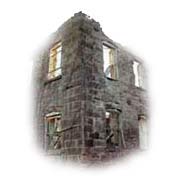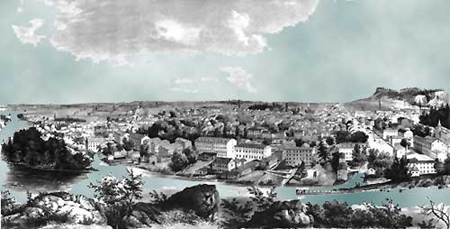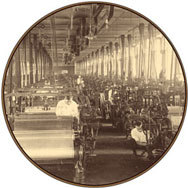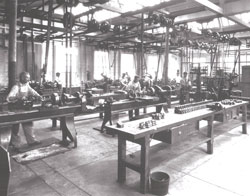
 |
 |
|
|
The Site The Allied Textile Printing (ATP) Site A 7-acre parcel of land within the historic district, known as the Allied Textile Printing (ATP) Site, is owned by the City of Paterson and is being considered for development. The ATP site is especially crucial to the historic district, not only because of the historic value of the structures within the site, but because of the terrain and location. It is adjacent to the Passaic River, across form the Valley of the Rocks, and directly below the beautiful Great Falls. It contains the third tier of the water raceway, including head and tailraces, and the remains of a complex collection of 30 mill buildings including portions of the Colt, Waverly, Todd, and Passaic Mills. This area was one of the first
locations developed by the S.U.M. In 1794, the Society, as it was called,
established a shop for printing, bleaching and dying. This new mill measured 90
by 40 feet and was four stories high. Textiles were produced continuously on the A.T.P. site for 200 years. The adaptive nature of these mills allowed their uses to change over time. In 1840, John Ryle produced the nation's first skein of silk here. During the late 19th century and early 20th century Paterson was known as the "Silk City" of the world. At that time, approximately 121 firms in Paterson, involved in every facet of manufacturing the silk product, employed thousands of workers in their mills. The Waverly and Mallory mills of the 1840's and 1850's were only some of the large-scale silk mills which survived into the modern era under the corporate structure of Allied Textile Printers (A.T.P.). Probably the most famous single building in Paterson is the Colt Gun Mill. This mill, on the A.T.P. site, is where Samuel Colt constructed his first production revolvers, known to collectors and historians as the Colt "Paterson." Unfortunately, a series of fires began in 1983 devastating the area around the Colt Mill on the ATP site. These buildings have been reduced to decaying brick shells. Demolition by neglect has been a tragic theme in Paterson, and in particular, the Great Falls Historic District. The entire district has been listed since 1988 as a Priority One Threatened NHL in the Department of Interior's annual report to Congress on NHLs, based primarily on the condition of the ATP site.  The
$1.67 Million in federal funding that was earmarked for the A.T.P. Site's
stabilization, environmental cleanup, and archeological studies had been held up
by the city's contract for an inappropriate pre-fabricated townhouse development
on the site. The recent dedesignation of the housing developer was a major
victory for concerned citizens and organizations and a step forward in the
enhancement of the district's heritage tourism. However, there still continues
to be a fractured and fierce controversy over the future of the site. The
$1.67 Million in federal funding that was earmarked for the A.T.P. Site's
stabilization, environmental cleanup, and archeological studies had been held up
by the city's contract for an inappropriate pre-fabricated townhouse development
on the site. The recent dedesignation of the housing developer was a major
victory for concerned citizens and organizations and a step forward in the
enhancement of the district's heritage tourism. However, there still continues
to be a fractured and fierce controversy over the future of the site.
The current threat is the possible destruction of the ATP Site's remaining waterpower remnants and the lost opportunity to interpret them. Fortunately, there is mounting pressure from many people, organizations and political entities to conserve the historical ruins on the site. A genuine conservation and restoration of the ATP Site will draw people visiting the natural landmark Great Falls onto the ATP Site and into the rest of the historic district. This is absolutely necessary for a national park option. It will be a sad chapter of restoration history if this land and waterpower remains are not converted into a superb park that will keep these unique waterpower remnants as a monument to early America's ingenuity and hard work.
Paterson Friends of the Great Falls was created to help advance the Great Falls / S.U.M. National Historic Landmark District as a heritage tourism destination. We advocate both the protection of the natural environment and the interpretation of this historic resource, including public access on the entire A.T.P. Site. We believe that the natural amphitheater on the western side, which was created when brownstone was quarried, should be improved for use as a public gathering space. This takes great advantage of the beautiful riverfront scenery below the falls and across the river at the Valley of the Rocks. The mill and waterpower remains on the eastern side should be stabilized for historic interpretation.
We hope that you will be inspired to help find lasting opportunities for this historic district's preservation and economic growth. It would be a quality example of the integration of environmental protection and historic preservation of an industrial center in a hardened urban city. |


 The textile industry here continued throughout the economic reverses of many
decades, evolving from the small shops which did carding and fulling to larger
businesses where considerable yarns and fabrics were made.
The textile industry here continued throughout the economic reverses of many
decades, evolving from the small shops which did carding and fulling to larger
businesses where considerable yarns and fabrics were made. The
restoration of the Colt Gun Mill could demonstrate how a waterwheel drives
machinery with waterpower. This interpretive center could direct water from the
raceway by flumes to a waterwheel. It could demonstrate how the power from this
waterwheel can be transmitted through shafts, gears, and belts to individual
machines within the mill building. The water can then return to the river via
tailraces. An exhibit space could tell the story of Hamilton's ardent aim to
convert the United States from an agrarian society to a capitalistic one. And,
above all, an exhibit space could honor the countless men, women and children
who worked these important mills of early industrial America.
The
restoration of the Colt Gun Mill could demonstrate how a waterwheel drives
machinery with waterpower. This interpretive center could direct water from the
raceway by flumes to a waterwheel. It could demonstrate how the power from this
waterwheel can be transmitted through shafts, gears, and belts to individual
machines within the mill building. The water can then return to the river via
tailraces. An exhibit space could tell the story of Hamilton's ardent aim to
convert the United States from an agrarian society to a capitalistic one. And,
above all, an exhibit space could honor the countless men, women and children
who worked these important mills of early industrial America.